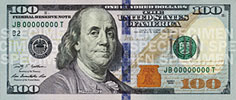Currency index
Advertisements
United States one hundred dollar bill

Description:
Size: 155.956 x 66.294 mm
Paper type: 75% cotton, 25% linen


The United States one hundred dollar bill ($100) is a denomination of
United States currency. U.S. statesman, inventor and diplomat Benjamin Franklin
is currently featured on the obverse of the bill. On the reverse of the banknote
is an image of Independence Hall. The time on the clock according to the U.S.
Bureau of Engraving and Printing, shows approximately 4:10 on the older contemporary notes and 10:30 on the series 2009A notes.If the time is converted to a date (April 10), it is possible that the time was chosen
because April 10th is the 100th day of the year.
The numeral four on the clock face is incorrectly written as "IV" whereas the
real Independence Hall clock face has "IIII". (See Roman numerals in clocks.)
The bill is one of two current notes that does not feature a President of the
United States; the other is the United States ten-dollar bill, featuring
Alexander Hamilton. It is the largest denomination that has been in circulation
since July 14, 1969, when the higher denominations of $500, $1,000, $5,000, and
$10,000 were retired.The Bureau of Engraving and Printing says the average life
of a $100 bill in circulation is 89 months (7 years) before it is replaced due
to wear and tear.
The bills are also commonly referred to as "Benjamins", in reference to the
use of Benjamin Franklin,s portrait on the denomination, or "C-Notes", based on
the Roman numeral for 100.
Approximately 29% of all notes produced in 2009 were $100 bills. One hundred
hundred-dollar bills are delivered by Federal Reserve Banks in mustard-colored
straps ($10,000).
The Series 2009 $100 bill redesign was unveiled on April 21, 2010, and was to
be issued to the public in February 11, 2011, but production was shut
down in December 2010 because as many as 30% were unusable due to a
manufacturing flaw. A vertical crease in the paper reveals a blank space on the
bill when pulled out. The new release date is October 8, 2013 and The Federal Reserve began supplying financial institutions with a redesigned 100 United States dollar note.
Security Features:
Security features can help you to tell if a 100 dollar bill is fake or real.
3-D Security Ribbon

Look for a blue
ribbon on the front of the 100 US dollar bill. Tilt the note back and forth while focusing on
the blue ribbon. You will see the bells change to 100s as they move.
When you tilt the note back and forth, the bells and 100s move side to
side. If you tilt it side to side, they move up and down. The ribbon is woven
into the paper, not printed on it.
Bell in the Inkwell

Look for an image
of a color-shifting bell, inside a copper-colored inkwell, on the front of the
new 100 US dollar bill. Tilt it to see the bell change from copper to green, an effect
which makes the bell seem to appear and disappear within the inkwell.
Color-Shifting Ink

Tilt the note to see the numeral 100 in the lower right corner of the note shift from copper to green.
Watermarks

Hold the note to light and look for a faint image
of Benjamin Franklin in the blank space to the right of the portrait. The watermark
is visible from either side of the note.
Security Thread

Hold the note to light to see an embedded thread that runs
vertically to the left of the portrait. The thread is imprinted with the letters USA and the numeral 100 in an alternating pattern and is visible along the thread from both sides of the note. The thread glows pink when
illuminated by ultraviolet light.
The redesigned 100 dollar bill remains the same size and uses the same, but enhanced portraits and historical images as the older-design bills, and most importantly, continues to be recognized around the world as quintessentially American.
Symbols of Freedom

The new 100 dollar bill’s American
symbols of freedom—phrases from the Declaration of Independence and the quill
the Founding Fathers used to sign the historic document—are found to the right
of the portrait.
Updated Portrait and Vignette

A portrait of Benjamin
Franklin, one of the Founding Fathers of the United States, remains on the front
of the new 100 US dollar bill. On the back, there is a new vignette of Independence Hall
featuring the back, rather than the front, of the building. The ovals around the
portrait and the vignette have been removed and the images have been enlarged.
Microprinting

Look carefully for small
printed words which appear on Benjamin Franklin’s jacket collar, around the
blank space where the portrait watermark appears, along the golden quill, and in
the note borders.
Federal Reserve Indicators

A universal seal
to the left of the portrait represents the entire Federal Reserve System. A
letter and number beneath the left serial number identifies the issuing Federal
Reserve Bank. There are 12 regional Federal Reserve Banks and 24 branches
located in major cities throughout the United States.
Serial Numbers

The unique combination of eleven numbers and
letters appears twice on the front of the bill. Because they are unique
identifiers, serial numbers help law enforcement identify counterfeit notes, and
they also help the Bureau of Engraving and Printing track quality standards for
the notes they produce.
Under UV light

The security thread of the redesigned 100 United states dollars will show up and glows pink when illuminated by ultraviolet light. Banknote paper absorbs the UV light.
Large gold 100

Look for a large gold numeral 100 on the back of the 100 United States Dollar note. It helps to assist the visually impaired in detecting the note by touch.
Check this video of real vs fake 100 US dollar bill
In this video you can see a fake U.S 100 Dollar bill compared to a real one.
Sources:
uscurrency.gov
wikipedia.org











Follow currencyguide.eu